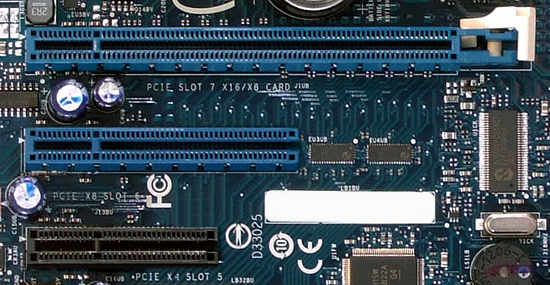GeForce And Radeon On Intel's P67: PCIe Scaling Explored
Intel’s Sandy Bridge-based processors dramatically advance gaming value by increasing performance at lower prices than LGA 1366-based configurations. But is the platform it sits on worthy of that CPU? We test three slot configurations to find out.
Are Sixteen Lanes Enough?
Tom's Hardware's Three-Part, 3-Way Graphics Scaling Series
Part 1, The Cards: Triple-GPU Scaling: AMD CrossFire Vs. Nvidia SLI
Part 2, The Slots: GeForce And Radeon On Intel's P67: PCIe Scaling Explored
Part 3, The Chipsets: P67, X58, And NF200: The Best Platform For CrossFire And SLI
We’re constantly impressed by the performance of Intel’s latest processors, which offer both higher IPC (instructions per cycle) and better overclocking headroom than anything seen previously. This is particularly true in games, where the extra execution resources in Intel's Core i7-990X go unused anyway.
Yet, in spite of the Sandy Bridge architecture's superior gaming performance (or at least better value, since you don't need to spend $1000 on a six-core processor to get equivalent frame rates), many enthusiasts insist on the added expandability of the old LGA 1366 platform. This makes sense in light of the P67’s incredible handicap: namely its 16-lane processor-based PCIe graphics interface.
But do we really need more than 16 lanes? Aren’t eight lanes enough for a single card? If that’s true, expensive and power-robbing PCIe bridges certainly wouldn't be necessary to support multiple cards. We’ve even heard stories that the PCIe 2.0 x4 slot supported through the P67 chipset is adequate for some graphics cards.
Before we move on to see how the P67-based platform stands up against the X58- and NF200-enhanced versions of both, let's get to the basics of PCIe scaling using modern cards on the best-possible gaming processor. This is Part 2 of our multi-card scaling series, but will there be enough graphics performance difference between various slots to justify a Part 3?
Get Tom's Hardware's best news and in-depth reviews, straight to your inbox.
Current page: Are Sixteen Lanes Enough?
Next Page Test Hardware And Benchmarks-
geofelt These tests were done with a single card, on X16/X8/X4 slots. Fine.Reply
But... Who would use anything other than a X16 slot if they had one?
The only real use for a X8 slot would be for sli/crossfire where the addition of a second card should result in an Increase of performance, not a decrease. -
carlhenry it would be nice if you included the GTX 570 in the x8/x8 and x16/x4 test. the 570 flies over the 6950 on the single card config but i was curious how it would do since i think the AMD's scale better than nvidia's. would the 570 still lead because of its advantage? or would AMD even it out because of its scaling (if any) "advantage"Reply -
joytech22 Can you guy's do an article on how performance is affected if you SLI/Xfire using PCI-E 16x slots running @ 4x?Reply
3 way would be preferable because if performance is still adequately faster I'll consider it. -
dalauder Good comments. Can we please see 8x/8x and 16x/4x since that comparison is relevant? I get the impression that somehow SLI/crossfire reduces the performance hit of x4 lanes but I'd like to see numbers.Reply -
Crashman joytech22Can you guy's do an article on how performance is affected if you SLI/Xfire using PCI-E 16x slots running @ 4x?I think you missed a page then!Reply
http://www.tomshardware.com/reviews/pci-express-scaling-p67-chipset-gaming-performance,2887-10.html
The numbers were there all along!
carlhenryit would be nice if you included the GTX 570 in the x8/x8 and x16/x4 test.Well, you should probably read the linked page too then. There's no point in artifically creating a configuration (by taping lanes or whatever) that doesn't exist in real life, is there?
"While Nvidia prevents SLI from functioning on PCH-hosted lanes, x16/x4 configurations are completely possible in CrossFire. But should they be? We tested our motherboard in both x8/x8 and x16/x4 configurations to find out." -
Crashman dalauderYeah...my bad.I didn't mean to call you out to that extent, here's a link to the forum part of this thread:Reply
http://www.tomshardware.com/forum/2887-56-geforce-radeon-intel-pcie-scaling-explored
I'm going there to delete your quote from my response. -
cats_Paw Im guessing that 8x lanes are mostly enought. I do belive that it would depend on how fast an actual gpu is, as well as how much ram it has, and how big is its bandwidth.Reply
I means, its logical, but mayb not true :D. Would be nice to see this test on a GTX560 Ti, since it has a lot of headroom for OC, then compare oced version vs non oced. Also this might be interesting in GPUs that have diffrent versions with more and less RAM.
Just my 2 cents :D.


